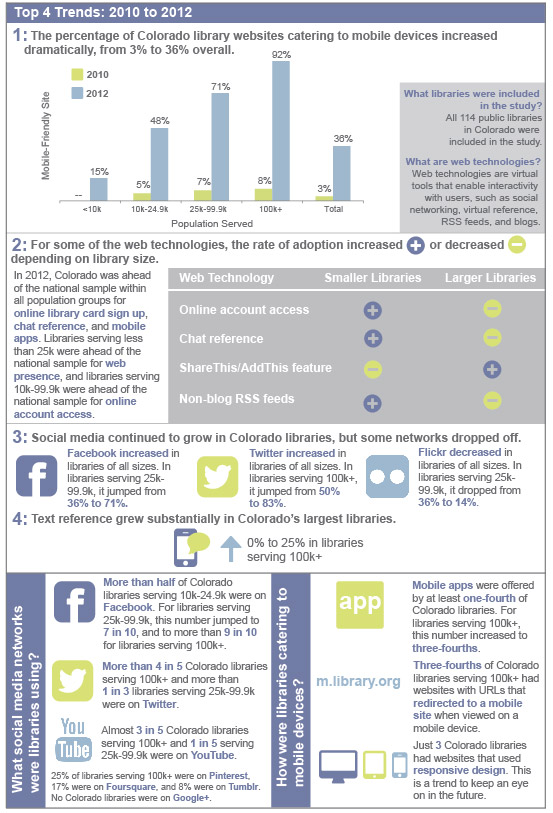In 2008, the Library Research Service launched the biennial study, U.S. Public Libraries and the Use of Web Technologies, with the intent to document the use of various web technologies on the websites of public libraries throughout the nation. From its inception, it was conceived as a longitudinal study, with plans to revisit the sample libraries every two years to track changes in libraries’ uses of web technologies. The study is conducted as a content analysis: researchers analyze a random sample, stratified based on legal service area (LSA) population, of public library websites throughout the United States (584 in 2012), as well as the websites of all public libraries in Colorado (114—9 of which are in the national sample). The results of the 2008 study set a baseline for the adoption of web technologies nationwide. The study was repeated in 2010 and 2012, and these iterations expanded upon the 2008 findings by tracking the trends in U.S. public libraries’ use of web technologies over time as well as by examining new technologies as they emerged. Highlights from the Colorado portion of the 2012 study are presented below, in both graphical and text format:
In 2012, 9 in 10 Colorado public libraries had websites, including:
- all of those serving LSA populations of 100,000+ and 10,000-24,999;
- 93 percent of those with LSA populations of 25,000-99,999; and,
- more than 4 in 5 (85%) of those serving LSA populations less than 10,000 (up from 79% in 2010).
Over time, Colorado public library websites were analyzed for the presence of several web features that enable interactivity with users (for example, virtual reference, blogs, etc.). Some notable findings included:
- Technologies that increased from 2010 to 2012 included: online library card sign up (9% to 17%), online account access (75% to 80%), email newsletter (18% to 27%), AddThis/ShareThis interface (18% to 24%), chat reference (59% to 67%), and text reference (1% to 4%).
- Technologies that decreased included blogs (21% to 15%) and email reference (25% to 22%).
- However, these trends varied depending on the library’s LSA population. The smallest libraries increased their adoption of many of the web technologies, with the exceptions of blogs (12% to 5%), AddThis/ShareThis interface (15% to 11%), and email reference (13% to 5%). The largest libraries decreased their use of online account access (100% to 92%), non-blog RSS feeds (67% to 58%), and chat reference (100% to 75%), while showing the biggest gains in online library card sign up (33% to 67%), AddThis/ShareThis interface (33% to 75%), and text reference (0% to 25%).
A little more than half (53%) of Colorado public libraries had social media accounts:
- Almost all (92%) of the largest libraries, close to three-fourths (71%) of libraries serving between 25,000 and 99,999, more than half (57%) of those serving 10,000 to 24,999, and 40 percent of the smallest libraries had at least one social media account.
- Of the 9 social networks that were analyzed, libraries were most likely to be on Facebook (51%). From 2010 to 2012, libraries serving 25,000-99,999 had the biggest jump in adoption of this social network, from 36 percent to 71 percent.
- About 1 in 5 (21%) Colorado public libraries were on Twitter and 1 in 10 were on YouTube or Flickr. However, Flickr decreased in all population groups; for example, 36 percent of libraries serving 25,000-99,999 used this social network in 2010 versus 14 percent in 2012.
- One-fourth of the largest libraries were on Pinterest, 17 percent each were on Foursquare and Vimeo, and 8 percent were on Tumblr.
- The largest libraries were on an average of 3.50 social networks out of the 9 included in the analysis, whereas the smallest libraries averaged less than 1.
Since 2010, the number of Colorado libraries that catered to mobile devices has increased dramatically, from 3 percent to 36 percent:
- More than 9 in 10 (92%) of the largest libraries, 71 percent of libraries serving between 25,000 and 99,999, nearly half (48%) of libraries serving between 10,000 and 24,999, and 15 percent of the smallest libraries offered some type of mobile-friendly website access.
In terms of the specific type of mobile access,
- About one-fourth (26%) of Colorado public libraries offered mobile applications (apps);
- 1 in 5 libraries had mobile versions of their sites (i.e., the URL redirects to a mobile version of the website when viewed on a mobile device); however,
- just 3 libraries used responsive design.
Related information:
- PDF version of this Fast Facts.
- Infographic summarizing Colorado results.
- Infographic summarizing national results
- Closer Look report, which contains detailed information about the national and Colorado-specific findings.
- U.S. Public Libraries and the Use of Web Technologies webpage, which contains all published information from the 2008, 2010, and 2012 studies.
